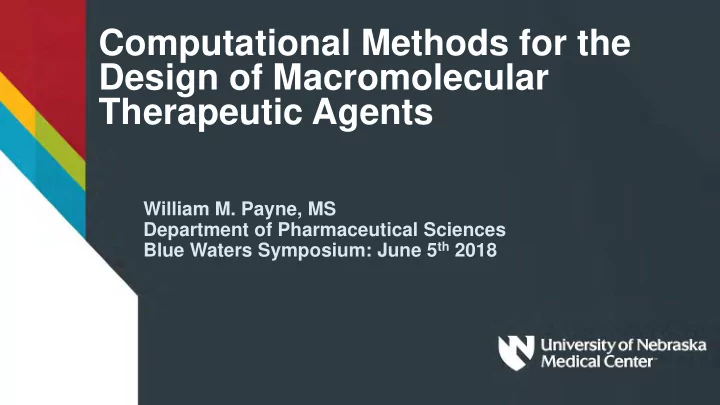

Computational Methods for the Design of Macromolecular Therapeutic Agents William M. Payne, MS Department of Pharmaceutical Sciences Blue Waters Symposium: June 5 th 2018
Introduction What is nanomedicine? - How do we improve therapeutic efficacy as an alternate strategy? - How is this different than traditional formulations? - The big question: what is a “good” nanoformulation?
Significance To move the field forward, we need better formulations. - Many nanoparticle formulations have been developed, but we do not have a way to say what is a “good” formulation. - Developing metrics for the physical description of nanoformulations will help to invent better formulations
Prior Work Context on the research - My research during Blue Waters and for after begins with experimental observations.
Prior Work More context - Drug delivery: freely encapsulated vs. covalent modification - Active targeting vs. passive targeting
Experimental Design Informing wet-lab science with theoretical insights - I needed a way to relate simulations to experimental processes. - Measurable interactions are key!
Learning simulations As an experimentalist, I had to learn everything - My first simulations were of very simple polymer conjugates to learn how to perform simulations
New Polymers Looking at aromatic substitutins - We increased the “library” of polymer models we use to include aromatic compounds gggg
New Models Moving to multi-polymer systems - Systems were simulated containing multiple polymer strands to observe self-assembly
Deeper-level measurement Using dyes to probe the internal environment - Fluorescent dyes can reveal information on their immediate environment
Simulating Dye-Polymer Systems - We can measure interactions between dyes and polymers to explain experimental observations - Aromatic vs. Aliphatic interactions
Experimental Analysis Fluorescence spectroscopy to validate simulations - We can perform spectroscopic measurements to gain more information on self-assembly
Back to the original problem How to improve the contrast obtained from polymer conjugates? - Moving to different polymers to improve imaging efficacy
Future Work Generalization and abstraction - HA is not a suitable model polymer. - Widespread applicability to the nanomedicine field is necessary for real impact. Poly(oxazoline) X N b N b N Y O O O R Poly(oxazine) X N b N b N Y O O O R
Conclusions - Simulations show promise in helping to inform the search for better formulations - Quantitative methods afforded through molecular dynamics and similar methods may help to define what is a “good” formulation - Using simulations in attempt to improve the formulation and original problem in polymeric contrast agents
Acknowledgements - PI: Aaron Mohs, PhD - Lab Members - Denis Svechkarev, PhD - Megan Holmes - Josh Souchek, PhD - Deep Bhattacharya, MPharm - Bowen Qi, MS Funding: - Nick Wojtynek - NIH R01 EB019449 - Collaborator: - Nebraska Research Initiative - Alexander Kyrychenko, PhD - Holland Computing Center Karazin Kharkiv National University, Ukraine - Blue Waters: - PoC: Robert Brunner - Blue Waters Support Staff
Recommend
More recommend